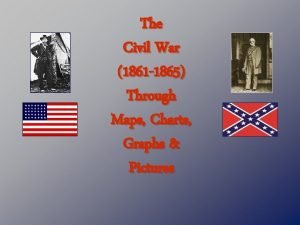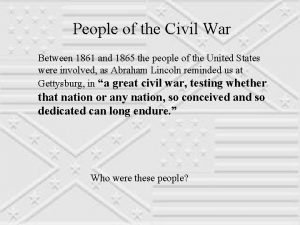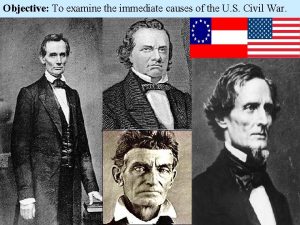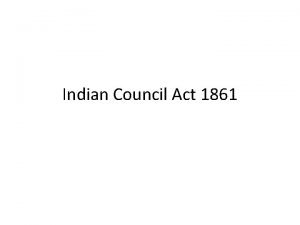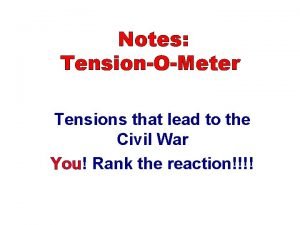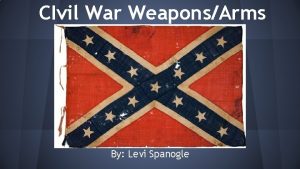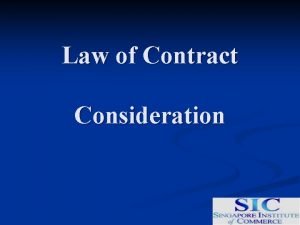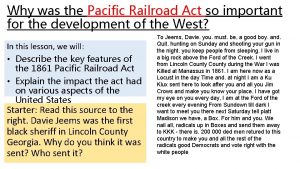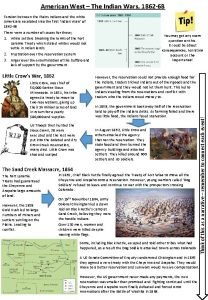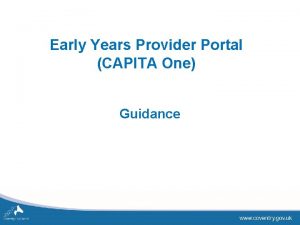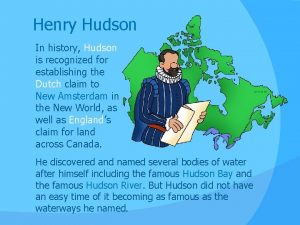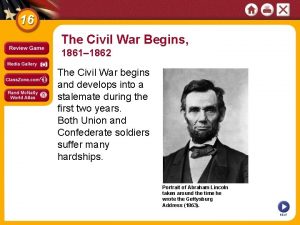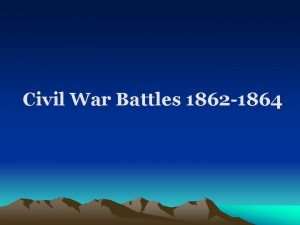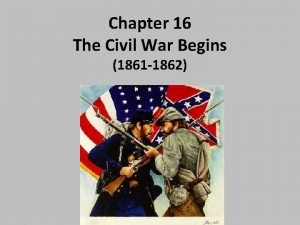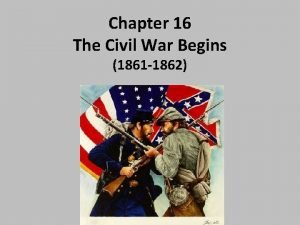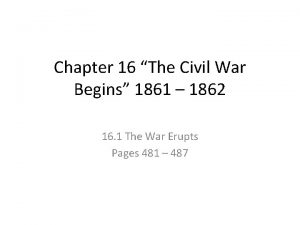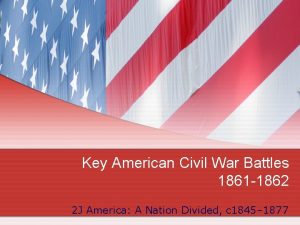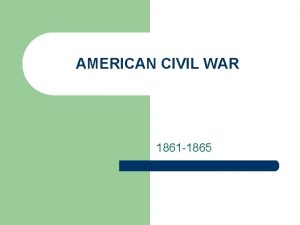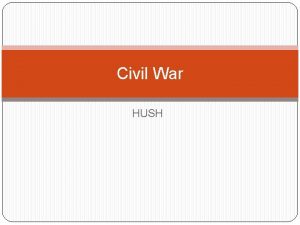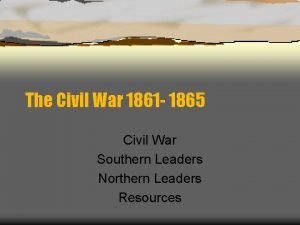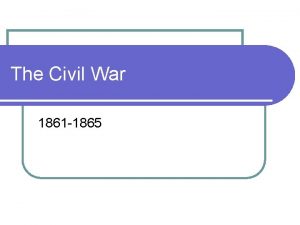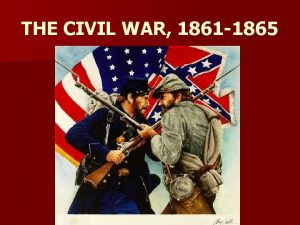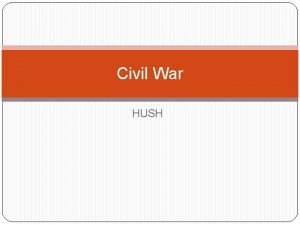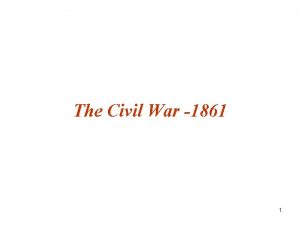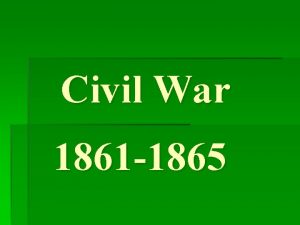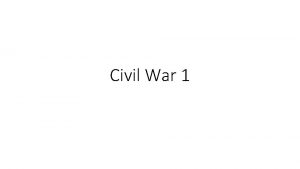THE CIVIL WAR The Early Years 1861 1862









































- Slides: 41

THE CIVIL WAR “The Early Years” 1861 - 1862









Plans for winning the war: • Union General Winfield Scott presented President Lincoln with the Union’s plan to win the war. It was called the Anaconda Plan. The union planned to win the war by “squeezing” the South. There were three parts to it:

1. SOUTH / EAST The Union planned to blockade the southern ports. This would halt the South’s trade with Europe. 2. WEST The Union planned to seize control of the Mississippi River. This would cut off any supply of goods to the South. Also, controlling the Mississippi would separate Arkansas, Texas and Louisiana from the rest of the Confederate states. 3. NORTH / EAST The Union planned to seize control of the Confederate capitol (Richmond Virginia) and capture the Confederate headquarters (Approx. 85 miles from Washington D. C. ).

Plans for winning the war: • Confederate The Confederate plan was quite simple: They would just stay at home and fight a defensive war by letting the Union troops come to them.

• November 1860 - Abraham Lincoln elected • December 1860 - Several states secede from the Union • March 1861 - Abraham Lincoln’s Inauguration Jefferson Davis’ Inauguration • April 1861 - Battle at Fort Sumter • July 1861 The Union began its blockade of the Confederate’s southern ports. First Battle of Bull Run

First Battle of Bull Run • In response to public demand, on July 21 st President Lincoln ordered an attack on Richmond, Virginia. • Troops, who had not been adequately trained, were led from Washington, D. C. under the guidance of General Irvin Mc. Dowell.

First Battle of Bull Run Shortly after leaving Washington, D. C. the Union troops clashed with Confederate troops at a small stream called Bull Run. (Manassas Junction, Virginia)

First Battle of Bull Run Inspired by General Thomas “Stonewall” Jackson, the Confederate troops held their ground.

First Battle of Bull Run • Eventually, the Union troops retreated. The Confederates did not pursue – if they had done so, they might have been able to capture Washington, D. C. • The First Battle of Bull Run showed: – Troops on both sides needed training – It was going to be a long, bloody war.

First Battle of Bull Run • UNION: – KIA – WIA – MIA = = = 451 1, 001 1, 741 • CONFEDERATE: – KIA – WIA – MIA = = = 362 1, 519 12

First Battle of Bull Run • After the First Battle of Bull Run, President Lincoln replaced General Irvin Mc. Dowell with George B. Mc. Clellan as Commander of the Union Army. • Mc. Clellan was a specialist at military organization and training.

January 1862 • President Lincoln issued a war order authorizing the Union to launch an aggressive attack on the Confederacy. • General Mc. Clellan ignored the President’s order because he felt that the Union troops were not ready.

March 1862 • General Mc. Clellan moves the Union troops into action. Union troops sail from Washington, D. C. to an area south of Richmond, Virginia. • Confederate General Robert E. Lee launched a series of counter attacks.

• General Lee also sent “Stonewall” Jackson with troops to threaten Washington, D. C. • Being cautious, General Mc. Clellan abandoned the attack on Richmond and returned to Washington, D. C.

Battle of the “Monitor” and the “Merrimack” In early July of 1861, the Union abandoned one of its naval ships, the “Merrimack” near Virginia. Confederates covered the ship with iron plates and sent it into battle against the Union navy.

March 8, 1862 • The “Merrimack” – now the “CSS Virginia” sank 1 Union ship, drove another aground, and forced another ship to surrender March 9, 1862 • The Union countered with the “Monitor” off the coast of Virginia. The “CSS Virginia” had more firepower, but the “Monitor” moved more easily.

In the end, neither ship seriously damaged the other, and both withdrew.

Battle of Shiloh (one of the bloodiest battles of the war) April 6 -7, 1862

Battle of Shiloh • Confederate forces attacked Union forces who were under the command of Ulysses S. Grant at Shiloh, Tennessee. • By the end of the day, the Union troops were almost defeated.

Battle of Shiloh • During the night, reinforcements arrived, and by the next morning the Union troops commanded the battlefield. • Casualties in this battle were heavy: – 13, 000 out of 63, 000 Union soldiers were killed – 11, 000 out of 40, 000 Confederate troops were killed 24, 000 out of 103, 000 = 23% Killed

May 1862 • Confederate General “Stonewall” Jackson, commanding forces in the Shenandoah Valley, attacked Union forces in late-May, forcing them to retreat across the Potomac River. • As a result, Union troops were rushed to protect Washington, D. C.

The Seven Days’ Battles • Between June 26 and July 2, Union and Confederate forces fought a series of battles: Mechanicsville Gaines’s Mill Savage Station Frayser’s Farm Malvern Hill June 26 & 27 June 29 June 30 July 1 On July 2, the Confederates withdrew to Richmond, Virginia.

Second Battle of Bull Run • The Second Battle of Bull Run was fought on August 29 -30, 1862. • The Union troops failed to commit to battle quickly enough – which led to another Confederate victory.

Battle of Harper’s Ferry • Union General Mc. Clellan’s forces defeated Confederate General Robert E. Lee’s forces at South Mountain and Crampton’s Gap in September, but did not move quickly enough to save Harper’s Ferry (Federal Gun Warehouse), which fell to Confederate General “Stonewall” Jackson’s forces on September 15, 1862.

Battle of Antietam • On September 17, 1862, Confederate forces under General Robert E. Lee were caught be General Mc. Clellan near Sharpsburg, Maryland. • This battle proved to be the bloodiest day of the war!


Battle of Antietam UNION: • 2, 108 soldiers KIA 9, 549 soldiers WIA CONFEDERATE: • 2, 700 soldiers KIA 9, 029 soldiers WIA TOTAL: • 4, 808 KIA 18, 578 WIA

Battle of Antietam • There was no clear winner, but because the Confederates withdrew to Virginia, the Union was considered the victor. • This battle convinced the French and British, who were considering supporting the Confederates in the war, not to get involved.

“Preliminary” Emancipation Proclamation • On September 22, President Abraham Lincoln issued the Preliminary Emancipation Proclamation, which would free all slaves in areas rebelling against the United States – effective January 1, 1863.

The Battle of Fredericksburg

The Battle of Fredericksburg • In December of 1862, Union forces, under the command of General Ambrose E. Burnside, were defeated in a series of attacks against entrenched Confederate forces at Fredericksburg, Virginia.

The Battle of Fredericksburg

The Battle of Fredericksburg
 Civil war 1861/1862
Civil war 1861/1862 Civil war 1861/1862
Civil war 1861/1862 Why was the civil war the first modern war
Why was the civil war the first modern war Toward civil war lesson 3 secession and war
Toward civil war lesson 3 secession and war John brown poster
John brown poster Features of indian council act 1861
Features of indian council act 1861 Tensionometer
Tensionometer Unionistička stranka 1861
Unionistička stranka 1861 Springfield model 1861 rifle facts
Springfield model 1861 rifle facts Lush j in currie v. misa
Lush j in currie v. misa 300 solar years to lunar years
300 solar years to lunar years Where is this image
Where is this image Goat years to human years
Goat years to human years Civil rights and civil liberties webquest
Civil rights and civil liberties webquest 1918-1862
1918-1862 The pacific railroad act of 1862
The pacific railroad act of 1862 Peintre viennois
Peintre viennois The indian wars 1862-68
The indian wars 1862-68 Simbolismo pictorico
Simbolismo pictorico Tongueofvalor
Tongueofvalor 1918-1862
1918-1862 Nato 1862
Nato 1862 1918-1862
1918-1862 1918-1862
1918-1862 1918-1862
1918-1862 El peto klimt
El peto klimt 1918-1862
1918-1862 1918-1862
1918-1862 Picasso paintings early years
Picasso paintings early years Early years teacher standards
Early years teacher standards Eylf meaning
Eylf meaning Nottingham city early years
Nottingham city early years Glasgow counts framework
Glasgow counts framework Bristol characteristics of effective learning
Bristol characteristics of effective learning Mark making early years
Mark making early years Problem solving in early years
Problem solving in early years Eye early years evaluation
Eye early years evaluation Summarise types of early years provision
Summarise types of early years provision Early years foundation stage pack
Early years foundation stage pack Coventry early years portal
Coventry early years portal What did henry hudson sail for
What did henry hudson sail for Family first hertfordshire
Family first hertfordshire
